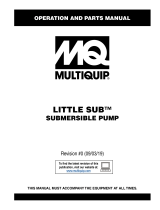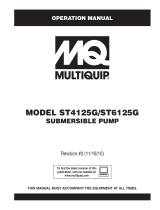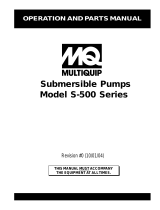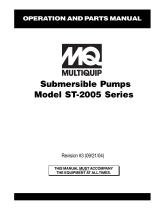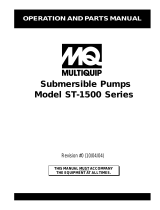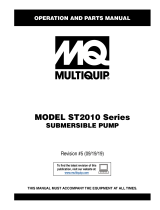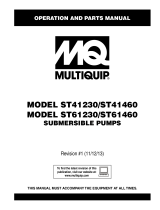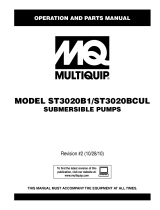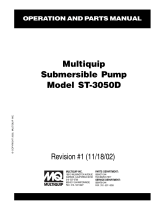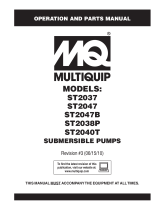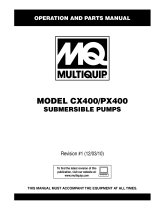Page is loading ...

PAGE 2 — ST4/ST6 SERIES SUBMERSIBLE PUMPS • OPERATION AND PARTS MANUAL — REV. #3 (05/25/21)
PROPOSITION 65 WARNING

ST4/ST6 SERIES SUBMERSIBLE PUMPS • OPERATION AND PARTS MANUAL — REV. #3 (05/25/21) — PAGE 3
TABLE OF CONTENTS
ST41230/ST41460
ST61230/ST61460
Submersible Pumps
Proposition 65 Warning ........................................... 2
Safety Information ................................................ 4-7
Specifications ........................................................... 8
Dimensions ............................................................. 9
General Information .............................................. 10
Components ......................................................... 11
Float Switches .................................................. 12-14
Overload Relay ...................................................... 15
Control Box Installation .................................... 16-17
Control Box Power Connections ........................... 18
Control Box Wiring Layout (CB126974) ................. 20
Control Box Wiring Layout (CB145663) ................. 21
Operation ......................................................... 22-23
Maintenance .................................................... 24-26
Troubleshooting .................................................... 27
Control Box Wiring Diagram (CB126974) .................28
Control Box Wiring Diagram (CB145663) .................29
Explanation Of Codes In Remarks Column .......... 30
Suggested Spare Parts ......................................... 31
Component Drawings
ST41230/ST41460 Assembly ........................... 32-35
ST61230/ST61460 Assembly ........................... 36-39
NOTICE
Specifications and part numbers are subject to change
without notice.

PAGE 4 — ST4/ST6 SERIES SUBMERSIBLE PUMPS • OPERATION AND PARTS MANUAL — REV. #3 (05/25/21)
SAFETY INFORMATION
Do not operate or service the equipment before reading
the entire manual. Safety precautions should be followed
at all times when operating this equipment.
Failure to read and understand the safety
messages and operating instructions could
result in injury to yourself and others.
SAFETY MESSAGES
The four safety messages shown below will inform you
about potential hazards that could injure you or others. The
safety messages specifi cally address the level of exposure
to the operator and are preceded by one of four words:
DANGER, WARNING, CAUTION
or NOTICE.
SAFETY SYMBOLS
DANGER
Indicates a hazardous situation which, if not avoided,
WILL result in DEATH or SERIOUS INJURY.
WARNING
Indicates a hazardous situation which, if not avoided,
COULD result in DEATH or SERIOUS INJURY.
CAUTION
Indicates a hazardous situation which, if not avoided,
COULD result in MINOR or MODERATE INJURY.
NOTICE
Addresses practices not related to personal injury.
Potential hazards associated with the operation of this
equipment will be referenced with hazard symbols which
may appear throughout this manual in conjunction with
safety messages.
Burn hazards
Symbol Safety Hazard
Electric shock hazards
Rotating parts hazards
Pressurized fluid hazards

ST4/ST6 SERIES SUBMERSIBLE PUMPS • OPERATION AND PARTS MANUAL — REV. #3 (05/25/21) — PAGE 5
SAFETY INFORMATION
GENERAL SAFETY
CAUTION
NEVER operate this equipment without proper protective
clothing, shatterproof glasses, respiratory protection,
hearing protection, steel-toed boots and other protective
devices required by the job or city and state regulations.
Avoid wearing jewelry or loose fi tting clothes that may
snag on the controls or moving parts as this can cause
serious injury.
NEVER operate this equipment when not
feeling well due to fatigue, illness or when
under medication.
NEVER operate this equipment under the
infl uence of drugs or alcohol.
ALWAYS clear the work area of any debris, tools, etc.
that would constitute a hazard while the equipment is
in operation.
No one other than the operator is to be in the working
area when the equipment is in operation.
DO NOT use the equipment for any purpose other than
its intended purposes or applications.
NOTICE
This equipment should only be operated by trained and
qualifi ed personnel 18 years of age and older.
Whenever necessary, replace nameplate, operation and
safety decals when they become diffi cult read.
Manufacturer does not assume responsibility for any
accident due to equipment modifi cations. Unauthorized
equipment modifi cation will void all warranties.
NEVER
use accessories or attachments that are not
recommended by Multiquip for this equipment. Damage
to the equipment and/or injury to user may result.
ALWAYS know the location of the nearest
fi re extinguisher.
ALWAYS know the location of the nearest
fi rst aid kit.
ALWAYS know the location of the nearest phone or
keep
a phone on the job site.
Also, know the phone numbers
of the nearest ambulance, doctor and
fi re department.
This information will be invaluable in the case of an
emergency.

PAGE 6 — ST4/ST6 SERIES SUBMERSIBLE PUMPS • OPERATION AND PARTS MANUAL — REV. #3 (05/25/21)
SAFETY INFORMATION
PUMP SAFETY
DANGER
NEVER operate the equipment in an explosive
atmosphere or near combustible materials. An
explosion or fi re could result causing severe
bodily harm or even death.
WARNING
Accidental starting can cause severe injury
or death. ALWAYS place the ON/OFF
switch in the OFF position.
DO NOT place hands or fingers inside
pump when pump is running.
NEVER disconnect any emergency or
safety devices. These devices are intended for operator
safety. Disconnection of these devices can cause severe
injury, bodily harm or even death. Disconnection of any
of these devices will void all warranties.
Risk of Electric Shock - This pump has not been
investigated for use in swimming pool or marine areas.
CAUTION
DO NOT restrict the fl ow of the discharge hose as it may
cause the pump to overheat.
Be careful of discharge hose whipping under pressure.
ALWAYS check pump oil level only when pump is cool.
Expansion due to heat may cause hot oil to spray from
the oil plug when the oil plug is removed. The possibility
of severe scalding may exist.
NOTICE
ALWAYS place the pump in an upright position on a
platform before using. The platform will prevent the pump
from burrowing itself on soft sand or mud.
NEVER operate pump on its side.
DO NOT allow the pump to freeze in water.
NEVER leave an open pump chamber unattended.
ALWAYS keep the machine in proper running condition.
DO NOT attempt to thaw out a frozen pump by using
a torch or other source of fl ame. Application of heat in
this manner may heat the oil in the seal cavity above the
critical point, causing pump damage.
DO NOT
pump water with a temperature greater than
140°F (60°C).
DO NOT pump liquids containing acid or alkali.
ALWAYS
check strainer before pumping. Make sure
strainer is not clogged. Remove any large objects, dirt
or debris from the strainer to prevent clogging.
ALWAYS
fl ush pump (clean) after use when pumping
water concentrated with heavy debris. It is very important
to always fl ush the pump before turning it off to prevent
clogging.
Fix damage to machine and replace any broken parts
immediately.
ALWAYS
store equipment properly when it is not being
used. Equipment should be stored in a clean, dry location
out of the reach of children and unauthorized personnel.
NEVER
lubricate components or attempt service on a
running machine.
NEVER run pump dry.
ALWAYS
allow the machine a proper amount of time to
cool before servicing.
Keep machine in proper running condition.
ELECTRICAL SAFETY
DANGER
The electrical voltage required to operate
pump can cause severe injury or even death
through physical contact with live circuits.
ALWAYS disconnect electrical power from
pump before performing maintenance on
pump.

ST4/ST6 SERIES SUBMERSIBLE PUMPS • OPERATION AND PARTS MANUAL — REV. #3 (05/25/21) — PAGE 7
SAFETY INFORMATION
NOTICE
ALWAYS make certain that the voltage supplied to the
pump is correct. Always read the pump’s nameplate to
determine what the power requirements are.
Power Cord/Cable Safety
DANGER
NEVER stand in water while AC power cord is connected
to a live power source.
NEVER use damaged or worn cables or cords. Inspect
for cuts in the insulation.
NEVER grab or touch a live power
cord or cable with wet hands. The
possibility exists of electrical shock,
electrocution or death.
Make sure power cables are securely connected to the
motor's output receptacles. Incorrect connections may
cause electrical shock and damage to the motor.
WARNING
NEVER attempt to use the power cord as a lifting or
lowering device for the pump.
NOTICE
ALWAYS make certain that proper power or extension
cord has been selected for the job. See Cable Selection
Chart in this manual.
Grounding Safety
DANGER
ALWAYS make sure pump is grounded.
NEVER use gas piping as an electrical ground.
ALWAYS make sure that electrical circuits are properly
grounded to a suitable earth ground (ground rod) per
the National Electrical Code (NEC) and local codes
before operating generator. Severe injury or death by
electrocution can result from operating an ungrounded
motor.
Control Box Safety
DANGER
ALWAYS
have a qualifi ed electrician perform the control
box installation. The possibility exists of electrical shock
or electrocution.
NOTICE
ALWAYS
mount control box in a vertical position
protected from harsh environmental elements.
LIFTING SAFETY
CAUTION
When raising or lowering of the pump is required, always
attach an adequate rope or lifting device to the correct
lifting point (handle) on the pump.
NOTICE
DO NOT lift machine to unnecessary heights.
NEVER
lift the equipment while the electric motor is
running.
TRANSPORTING SAFETY
NOTICE
ALWAYS shut down pump before transporting.
ALWAYS
tie down equipment during transport by
securing the equipment with rope.
ENVIRONMENTAL SAFETY/DECOMMISSIONING
CE
DO NOT pour waste or oil directly onto
the ground, down a drain or into any water
source.
Contact your country's Department of Public
Works or recycling agency in your area and arrange for
proper disposal of any electrical components, waste or
oil associated with this equipment.
When the life cycle of this equipment is over it is
recommended that the pump casing and all other metal
parts be sent to a recycling center
Metal recycling involves the collection of metal from
discarded products and its transformation into raw
materials to use in manufacturing a new product.
Recyclers and manufacturers alike promote the process
of recycling metal. Using a metal recycling center
promotes energy cost savings.

PAGE 8 — ST4/ST6 SERIES SUBMERSIBLE PUMPS • OPERATION AND PARTS MANUAL — REV. #3 (05/25/21)
SPECIFICATIONS
Table 1. Specifications
Model
ST41230 ST41460 ST61230 ST61460
Type
Centrifugal Centrifugal Centrifugal Centrifugal
Impeller
Chrome Steel Chrome Steel Chrome Steel Chrome Steel
Discharge Size in. (mm)
4.00 (101) 4.00 (101) 6.00 (152) 6.00 (152)
Max Solids in. (mm)
0.60 in (15.2)
Maximum Pumping Capacity
gallons/min (liters/min.)
423 (1,600) 423 (1,600) 674 (2,450) 674 (2,450)
Max Head ft. (m)
138 ft. (42.1) 138 ft. (42.1) 105 ft. (32.5) 105 ft. (32.5)
Power HP (kW)
10 (7.5) 10 (7.5) 15 (11) 15 (11)
Frequency Hz.
60
Voltage (Phase)
230 (3Ø) 460 (3Ø) 230 (3Ø) 460 (3Ø)
Starting Amps (Volts)
172.2 (230) 85.8 (460) 258 (230) 129 (460)
Running Amps (Volts)
28.6 (230) 14.3 (460) 43 (230) 21.5 (460)
Maximum Temperature
°F (°C)
140°F (60°C)
Oil Chamber Capacity oz. (cc)
40 (1,200) 47 (1,400)
Lubrication Oil
ISO VG32 or Equivalent
Mechanical Seal
See Note 2 See Note 2 See Note 2 See Note 2
Motor Speed RPM
3,600
Enclosure Protection
IP68
Insulation Class
F
Power Cable Length ft. (m)
33 (10)
Weight lbs. (kg)
205 (93) 205 (93) 301 (137) 301 (137)
Control Box
See Note 3 See Note 3 See Note 3 See Note 3
Note 1:
Motor Rotation – Let pump hang freely from a lifting device. Start and stop pump while observing movement (kick) of
pump. If connected correctly the impeller will rotate clockwise (CW) as viewed from above. If pump rotates counterclockwise
interchange any two phases from the power source.
Note 2:
Mechanical Seal Oil – Use ISO VG32 lubrication oil, Mobile DTE 24 turbine oil 90 or equivalent. Fill oil chamber 75%
to 85% full (allow air space for expansion).
Note 3:
Control Box - For unattended operation, CB1269, CB1274, CB1456, or CB1463 Control Boxes (Table 4) are required.
All control boxes provide thermal overload protection.

ST4/ST6 SERIES SUBMERSIBLE PUMPS • OPERATION AND PARTS MANUAL — REV. #3 (05/25/21) — PAGE 9
A
B
F
G
C
E
D
H
J
I
DIMENSIONS
Figure 1. Pump Dimensions
Table 2. Dimensions in. (mm)
REF. DES. ST41230/ST4160 REF. DES. ST61230/ST6160
A
11 (279)
F
14 (356)
B
11 (279)
G
14 (356)
C
32.5 (826)
H
34.75 (883)
D
5.5 (140)
I
5.5 (140)
E
28.25 (718)
J
31.0 (787)

PAGE 10 — ST4/ST6 SERIES SUBMERSIBLE PUMPS • OPERATION AND PARTS MANUAL — REV. #3 (05/25/21)
GENERAL INFORMATION
The Multiquip Model ST41230/ST41460 and ST61230/
ST61460 submersible pumps are designed to pump
water. These pumps work best when faced with high head
applications where you need an appreciable flow.
The pumping of flammable, toxic, corrosive, abrasive liquids
is strictly forbidden. These pumps are best suited for clear
water applications where maximum size of solids (debris)
does not exceed 0.6-inches (15.2 mm).
These pumps have a chrome steel body that is very durable
and able to withstand rough handling. The ST41230/
ST41460 comes with a 4-inch NPT threads for standard
hose connections, while the ST61230/ST61460 comes
with a 6-inch NPT threads for standard hose connections.
The pumps are designed with an industrial mechanical
seal. This seal assembly prevents the water that is being
pumped from entering the bearing housing of the pump
or simply the area between the motor face and the volute
where the shaft passes through. This seal assembly is oil
bathed for maximum lubrication and operational longevity.
For unattended pumping operations and water level control,
a specially engineered Control Box is available. The Control
Box provides safeguards that protect the pump motor from
over/under voltage; as well as provide external mechanical
Float Switch operations. Multiquip highly recommends the
use of selected Control Boxes to provide protection to the
motor.
Reference the Serial Plate of the pump before applying
power. Ensure that the voltage, phase, and cycles
corresponds to the power that will be applied for operations.
Allowing incorrect electrical power will severely damage the
motor of the pump.

ST4/ST6 SERIES SUBMERSIBLE PUMPS • OPERATION AND PARTS MANUAL — REV. #3 (05/25/21) — PAGE 11
COMPONENTS
Figure 2 shows the location of the basic components, for
the submersible pumps. Listed below is a brief explanation
of each component.
1. Strainer Base – This strainer base is made of stainless
steel which is resistant to hardware corrosion. For
dewatering purposes, always place the strainer base
on a platform.
2. Mechanical Seal – NEVER run the pump dry! The
mechanical seal prevents the water that is being
pumped from entering the bearing housing of the
pump or simply the area between the motor face and
the volute where the shaft passes through. This seal
assembly is oil bathed.
3. Electric Motor – These pumps use either a 230 VAC
or 460 VAC, 3Ø, 60 Hz electric motor. Reference
Table 1. for the electric motor for your model pump.
Consult with a licensed electrician before connecting
motor to a power source. Observe all city and local
safety codes.
4. Nameplate – Provides vital electrical pump information.
Always read this tag before applying power to the pump.
5. Discharge Port – Connect a 4-inch hose to this port
(NPT 4" threads). Remember to adequately support
the discharge hose to avoid stress on the pump.
6. Lifting Handle – Attach a suitable lifting device to this
handle capable of lifting about 200 lbs. (91 kg) NEVER
lift the pump by its power cord.
7. AC Power Cable – These pumps are supplied with a
33 ft. (10 meters) AC power cable. Always check for
signs of wear. NEVER use a defective power cable or
any additional extension cable that does not support
the power design of the pump. If extension cords are
required, contact an electrician to advise the type that
best supports your pump.
8. AC Power Cable Clamp – This fasteners helps
safeguard random pulling forces or strain against the
power cable. NEVER raise/lower the pump by power
cable.
9. Impeller – Impellers are constructed of chrome steel
to minimize wear and prolong service life.
10. Mechanical Seal Oil Plug – Remove this plug to
check and add ISO VG32 lubrication oil, Mobile DTE
24, turbine oil 90 or equivalent to the oil chamber. This
oil protects the mechanical seal. Oil chamber should
be full enough to cover seal spring.
11. Discharge Port – Connect a 6-inch hose to this port
(NPT 6" threads). Remember to adequately support the
discharge hose to avoid stress on the pump.
12. Eye Bolts – Attach a suitable lifting device to this
handle capable of lifting about 300 lbs. (136 kg).
NEVER lift the pump by its power cord! Lifting the
pump by the power cord will cause undue stress on
the cord and ultimately the cord will become dislodged
from the pump.
ST41230
ST41460
ST61230
ST61460
1
1
2
2
3
3
4
4
11
6
12
7
8
8
9
9
10
10
5
7
Figure 2. Submersible Pump Components

PAGE 12 — ST4/ST6 SERIES SUBMERSIBLE PUMPS • OPERATION AND PARTS MANUAL — REV. #3 (05/25/21)
FLOAT SWITCHES
Mechanical Float Switch
Mechanically activated float switches offer a reliable low
current control for dewatering applications.
How It Works
The mechanical float switch control will turn ON (close)
when the float tips 45° above -horizontal, indicating a high
level, and turns OFF (opens) when the float switch drops
45° below horizontal. Reference Figure 4 and Figure 5.
Maximum pumping range is 120 degrees. See Figure 3
below.
Figure 3. Pumping Range (Float Switch)
Pumping Range
The pumping range of the pump is determined by the float
switch tether cord. Use Table 3 as guide line to determine
your required pumping range. Pumping ranges are based
on non-turbulent conditions. Range may vary due to water
temperature and cord shape. Please note as the tether
length increases, so does the variance of the pumping
range.
PUMP
ON
60
60
120
PUMP
OFF
Table 3. Pumping Range
Tether Length
2 in.
5.08 cm.
4 in.
10.16 cm.
6 in.
15.24 cm.
8 in.
20.32 cm.
10 in.
25.4 cm.
12 in.
30.48 cm.
14 in.
35.56 cm.
16 in.
40.46 cm.
Pumping Range
6 in.
15.24 cm.
10 in.
25.4 cm.
14 in.
35.56 cm.
18 in.
45.72 cm.
22 in.
55.88 cm.
27 in.
68.58 cm.
31 in.
78.74 cm.
35 in.
88.9 cm.
Design Features
Float switch housings are constructed of high-impact,
corrosion resistant polypropylene with mechanically
activated, snap action contacts.
Suitable for most liquid environments.
Hermetically sealed.
Thick-walled non-corrosive PVC plastic enclosure.
Pressure tested to 30 ft. (9 meters).
Standard SJO, 16-gauge, 2 conductor cord (20 ft./6.09 m).
Figure 4. Float Switch (Closed)
Figure 5. Float Switch (Open)
ON/OFF
RAMP
STEEL
BALL
CONTACTS
CLOSED
ON/OFF
RAMP
STEEL
BALL
CONTACTS
OPEN

ST4/ST6 SERIES SUBMERSIBLE PUMPS • OPERATION AND PARTS MANUAL — REV. #3 (05/25/21) — PAGE 13
Float Switches
For unattended operation of the submersible pump two
single float switches (Model SW1WOPA) will be required.
These float switches can be connected directly to a control
box (bare wires) and will allow the pump to turn on and off
depending on the length of the tether.
FLOAT SWITCHES
Figure 6. Float Switch Application
Mounting The Float Switches
1. Determine the required cord tether length as shown
in Figure 3 and Table 3.
2. Place the cord into the clamp as shown in Figure 6.
3. Secure the clamp to the discharge hose as shown in
Figure 6. DO NOT install cord under hose clamp.
4. Using a screwdriver, tighten the hose clamp. DO NOT
over-tighten. Make sure the float cord is not allowed to
touch the excess hose clamp band during operation.
PUMPING
RANGE
MODEL SW-1WO PA
FLOA TSWITCH (2 )
3.5 in.(9cm.)
MINIMUM
TETHER
LENGTH
PUMP
ON
PUMP
OFF
DISCHARGE
HOSE
INPUT POWER
TO CONTROL BOX
FLOATSWITCH
CABLES (2)
CONTROL
BOX
CAUTION!
HIGH
VOLTAGE!
RESET
PUMP POWER
CB1269
CB1274
CB1456
CB1463
CABLE
EXTERNAL 3-PHASE
(230 OR 460 VOLT)
POWER SOURCE
CIRCUIT
BREAKER
RED
WHITE
BLACK
L1
L2
L3
GREEN
GND.

PAGE 14 — ST4/ST6 SERIES SUBMERSIBLE PUMPS • OPERATION AND PARTS MANUAL — REV. #3 (05/25/21)
FLOAT SWITCHES
Control Boxes
For pumping applications that require unattended pumping
level operations, the proper Control Box and Float Switches
will be required (Figure 7).
For each submersible pump model there is an associated
control box that is recommended for standard and Float
Switch controlled operations. Reference Table 4 for the
required control box.
These water resistant control boxes provide ON/OFF/AUTO
pump functioning, pump electronic overload protection and
internal connection points for Float Switch operations.
Each pump requires its individually specified Control Box.
For Float Switch operations, two MQ model: SW1WOPA
float switches (Contact MQ Sales) are recommended.
Reference Figure 22 and Figure 23 for a schematic
representation of each control box.
NOTICE
Contact Multiquip sales department to order control
boxes as listed in Table 4.
Figure 7. Electrical Control Box
(Typical)
CAUTION!
HIGH
VOLTAGE!
RESET
MAN
OFF
AUTO
Table 4. Control Box Specifications
Control Box
Model No.
Used With
Pump Model
Voltage,
3Ø
Running
Amps
UL/CSA
Listed
Thermal
Overload
Protection
Float
Switch
Capability
CB126974
ST41230 230 28.6 YES YES YES
ST61230 230 43.0 YES YES YES
CB145663
ST41460 460 14.3 YES YES YES
ST61460 460 21.5 YES YES YES

ST4/ST6 SERIES SUBMERSIBLE PUMPS • OPERATION AND PARTS MANUAL — REV. #3 (05/25/21) — PAGE 15
OVERLOAD RELAY
Overload Relay
When the CB126974/CB145663 Control Boxes are
employed, the Siemens EPS200 overload relay must be
configured for correct operating protection. Reference
Figure 8 for the correct setting for the full load amps (FLA)
dial and the trip class dip switches.
NOTICE
If the EPS200 overload relay is not set correctly, it
will trip too soon. The EPS200 oveload relay must be
adjusted to match the 4 or 6 inch pump motor voltage.
NOTICE
Trip class is defined as the length of time for the relay
to OPEN in an overload condition.
CB126974 3Ø 230 VAC FLA SETTING
1. Open the the control box door by unlocking the two
release latches located on the side of the control box
2. When using a 4-inch pump @ 230 VAC, turn the full
load amps (FLA) adjustment dial to the 28.6 amp
position as show in Figure 8A.
3. When using a 6-inch pump @ 460 VAC, turn the full
load amps (FLA) adjustment dial to the 43.0 amp
position as show in Figure 8B.
4. Set the six trip class dip switches to the correct
operating protection position as shown in Figure 8C.
5. Close control box door and secure door with latches.
CB145663 3Ø 460 VAC FLA SETTING
1. Open the the control box door by unlocking the two
release latches located on the side of the control box
2. When using a 4-inch pump @ 460 VAC, turn the full
load amps (FLA) adjustment dial to the 14.3 amp
position as show in Figure 8D.
3. When using a 6-inch pump @ 460 VAC, turn the full
load amps (FLA) adjustment dial to the 21.5 amp
position as show in Figure 8E.
4. Set the six trip class dip switches to the correct
operating protection position as shown in Figure 8C.
5. Close control box door and secure door with latches.
Figure 8. ESP200 Overload Relay
TRIP CLASS DIP
SWITCHES (6)
C
A
4-INCH PUMP 230 VAC @ 10HP
SET FLA TO 28.6
D
4-INCH PUMP 460 VAC @ 10HP
SET FLA TO 14.3
FULL LOAD AMPS
(FLA) ADJUSTMENT DIAL
20
25
30
35
40
10
15
FULL LOAD AMPS
(FLA) ADJUSTMENT DIAL
OFF
ON
OFF
AUTORESET MODE MAN.
GROUND FAULT
ON
ON
PHASE UNBAL
PHASE LOSS
TRIP
CLASS 10
OFF
ESP200
SIEMENS
OVERLOAD
RELAY
GROUND FAULT
OFF
ON
OFF
AUTORESET MODE MAN.
ON
ON
PHASE UNBAL
PHASE LOSS
TRIP
CLASS 10
OFF
RESET
97
97
95
96
A3 A3
FULL LOAD AMPS
(FLA) ADJUSTMENT DIAL
TEST
TRIP CLASS
20
30
5
10
20
25
30
35
40
10
15
B
6-INCH PUMP 230 VAC @ 15HP
SET FLA TO 43.0
20
25
30
35
40
10
15
E
6-INCH PUMP 460 VAC @ 15HP
SET FLA TO 21.5
20
25
30
35
40
10
15

PAGE 16 — ST4/ST6 SERIES SUBMERSIBLE PUMPS • OPERATION AND PARTS MANUAL — REV. #3 (05/25/21)
CONTROL BOX INSTALLATION
Control Box Installation
The following procedure outlines the steps for connecting
the pump to a control box.
DANGER
Each submersible pump is designed to
work with a control box.This control box
contains the necessary electronics (float
switch connections) to operate the pump.
Remember this control box contains
hazardous voltages. Disconnect all sources of power
before installing or servicing. There exists the possibility
of electrocution, electric shock or burn, which can cause
severe bodily harm or even death!
DANGER
When installing the control box, the
possibility exists of electrical shock,
electrocution and possibly death! NEVER
have untrained personnel perform the
installation. ALWAYS have qualified
service personnel (licensed electrician) perform the
installation.
WARNING
Explosion or Fire Hazard exists if this pump
is used with flammable liquids. DO NOT use
this pump with flammable liquids. DO NOT
install this pump in hazardous locations as
defined by the National Electrical Code,
ANSI/NFPA 70.
CONTROL BOX MOUNTING
Mount the control box in an upright vertical position. Make
sure the control box is securely fastened to a flat surface,
that is free of dust, dirt, moisture or any elements that
may contaminate or erode the electronic components of
the control box.
3-Phase Power Installation (Input)
Each pump is either configured for 230 or 460 VAC voltage
input. Reference Table 1 for the correct input voltage for
your pump.
If you cannot determine what your pump's power
requirements are, look at the vendor supplied identification
name tag attached to the pump or please contact Multiquip's
Service/Technical Assistance department.
Power Cord Requirements
When routing the 230/460 VAC, 60 Hz., 3-phase power
via a power cord to the control box, ALWAYS use the
correct wire size. Please refer to Table 5 to determine the
correct wire size. Incorrect wire size can adversely affect
the performance of the pump and may ultimately burn out
the pump motor.
CAUTION
Applying incorrect power (voltage phasing) to the
submersible pump can cause severe damage to the
pump. Please make sure that the correct voltage and
phase are applied to the pump at all times.
Table 5. Power Cord Length
and Wire Size
AMPS
10 FT.
(3.0 m)
20 FT.
(6.0 m)
30 FT.
(9.1 m)
50 FT.
(15.2 m)
15 12 AWG 10 AWG 8 AWG 6 AWG
20 10 AWG 8 AWG 6 AWG 4 AWG
25 10 AWG 6 AWG 6 AWG 4 AWG
30 10 AWG 6 AWG 4 AWG 2 AWG
40 8 AWG 6 AWG 4 AWG 2 AWG

ST4/ST6 SERIES SUBMERSIBLE PUMPS • OPERATION AND PARTS MANUAL — REV. #3 (05/25/21) — PAGE 17
CONTROL BOX INSTALLATION
Connecting SW1WOPA Float Switches to Control
Box
1. Remove the float switch input connector housing, then
route the float switch wires through the cable gland on
the control box. Attach the wires of the float switch to
the terminal block as indicated by Table 6 and Figure 9.
2. Tighten the connector housing to ensure a tight fit
between the cord and the connector body. This will
prevent the cable from pulling out of the terminal block
and also prevent moisture from entering the control box.
3. Determine the tether length of the float switch wires
then secure float switch wires to pump discharge hose.
See Figure 3 and Table 3 to determine the pumping
range.
Table 6. Dual Float switch Connections
Float
Switch
Terminal
Block No.
Wire
Color
Start
TB1-A1
TB1-A2
Black
White
Stop
TB1-A3
TB1-A4
Black
White

PAGE 18 — ST4/ST6 SERIES SUBMERSIBLE PUMPS • OPERATION AND PARTS MANUAL — REV. #3 (05/25/21)
CONTROL BOX POWER CONNECTIONS
3-Phase Power Installation (Input to Control Box)
1. The 3-phase input power cord should have four wires.
Each wire is color coded. The colors are RED, WHITE,
BLACK and GREEN.
2. Remove the 3-phase AC input connector housing from
the control box, then route the three phase input power
cable through the cable gland on the control box. Attach
the wires to the AC terminal block inside the control
box as indicated by Table 7 and Figure 9.
3. Tighten the connector housing to ensure a tight fit
between the power cord and the connector body. This
will prevent the cable from pulling out of the terminal
block and also prevent moisture from entering the
control box.
4. Connect the other end of the 3-phase input power cord
to the voltage source. Remember to provide a means
of disconnecting the power from the control box (circuit
breaker or quick disconnect switch). Also make sure
to provide a good earth ground to the control box.
Table 7. 3Ø-230/460 VAC
Input Power Connections
Wire Color
Input Power
Terminal Block
RED L1
WHITE L2
BLACK L3
GREEN GROUND
NOTICE
It is recommended that the power being supplied to the
control box ALWAYS be connected to a circuit breaker
or a quick disconnect switch. This safety feature allows
for quick removal of power from the control box in the
event of an emergency.
3-Phase Power Installation (Output To Pump)
1. The 3-phase output power cord should have four wires.
Each wire is color coded. The colors are RED, WHITE,
BLACK and GREEN.
2. Remove the 3-phase AC output power connector
housing on the control box, then route the output power
cable through the cable gland on the control box.
Attach the wires to the AC terminals on the overload
relay module (heaters load side) as indicated by
Table 8 and Figure 9.
Table 8. 3Ø-230/460 VAC
Output Power Connections
Wire Color
Output Power
Overload Relay
RED T1
WHITE T2
BLACK T3
GREEN GROUND

ST4/ST6 SERIES SUBMERSIBLE PUMPS • OPERATION AND PARTS MANUAL — REV. #3 (05/25/21) — PAGE 19
NOTES

PAGE 20 — ST4/ST6 SERIES SUBMERSIBLE PUMPS • OPERATION AND PARTS MANUAL — REV. #3 (05/25/21)
CONTROL BOX CB126974 WIRING LAYOUT (3Ø-230 VAC)
Figure 9. Three Phase
Control Box CB126974/Pump System Diagram
MANUAL / AUTO
TERMINAL BLOCK
SWITCH
OFF / ON
TRANSFORMER
LAMP
CONTACTOR
MOUNT CONTROL
BOX IN AN UP-LEFT
VERTICAL POSITION
AS SHOWN.
OVERLOAD
RELAY
3 PHASE
AC OUTPUT
POWER CABLE
3 PHASE
AC INPUT
POWER CABLE
EXTERNAL 3-PHASE
(230 OR 460 VOLT)
POWER SOURCE
CIRCUIT
BREAKER
RED
WHITE
BLACK
L1
L2
L3
GREEN
3. STOP FLOAT
SWITCH CONNECT TO
TERMINALS 3 AND 4
2. START FLOAT
SWITCH CONNECT TO
TERMINALS 1 AND 2
1. SECURE FLOAT SWITCH
WIRES TO PUMP
DISCHARGE HOSE
PUMPING
RANGE
WARNING
CONTROL BOX INSTALLATION IS TO BE
PERFORMED BY A LICENSED ELECTRICIAN
OR QUALIFIED PERSONNEL.
THE POSSIBILITY OF ELECTRICAL SHOCK
OR ELECTROCUTION EXISTS, WHICH COULD
CAUSE SEVERE BODILY HARM EVEN DEATH!
95 96
GRN
GRN
RED
RESET
RED
BLK
BLK
WHT
WHT
14
13
5L3
H1
A1
A2
X2 XF
H4
/


